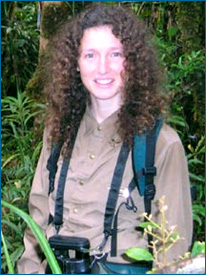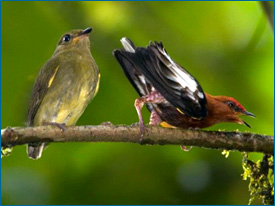
In 1997, armed with a camcorder, Kim traveled to Equador to see the club-winged manakin for herself. Though she’d read the one existing description of its behavior, she was deeply struck by what she heard and saw when she first encountered the bird in the wild. Its wing sound was loud and strangely musical, and the bird moved its wings so quickly that they looked like a blur. Even her camera couldn’t capture what the wings were doing. Furthermore, the wing noise turned out to be only a small part of a mating ritual that involved a repeated set of clicks and violin-like hums, bunny-hopping side to side on a tree branch, and one move sure to sweep any female off her feet: when feeling particularly amorous, the male club-winged manakin alights on the same branch as a female, turns away from her, bends over, throwing his rump in the air, and hops backwards towards her, switching his feet in a loose approximation of the “running man” dance, while he waggles his hind end. Kim still wanted to know how the humming sound was produced, but now she had a new question as well: how did such a crazy mating ritual evolve?

Back in Kansas, Kim wondered if that weird display of the club-winged manakin was really so unusual; her advisor, Richard Prum, had previously shown that closely related manakin species often perform elaborate courtship displays. Although the closest relatives to the club-winged manakin were unknown, perhaps there were other manakins that had similarly strange courtship displays. Kim dug into the literature and found reports on the odd mating behavior of a genus of manakins known as the Pipra. Reading further, she discovered more and more similarities with the club-winged manakin: they both have red or yellow plumage ornaments, they both display in the forest canopy, they both make wing sounds, and they both have complex mating dances that seemed to involve a “backwards” element. It didn’t seem likely that all these similarities in courtship behavior had evolved separately and by convergence. Kim reasoned that the similar elements of club-winged manakin and Pipra behavior, instead of being homoplasies, must have been passed down from a recent common ancestor that also had a complex mating display.

Though we usually think of homology in terms of anatomical characteristics, any traits that can be inherited — including genetic sequences, developmental pathways, and even behaviors — can be homologous. Kim points out that “homology is a surprisingly slippery concept.” Physical and behavioral traits are both underlain by developmental pathways, and these, in turn, are underlain by genetics. Evolutionary changes can occur at any level of this sequence. Furthermore, most structures and behaviors are composed of many different elements, any of which could persist as homologies through lineage splitting events. Hence, untangling homology in a complex trait or behavior, like the courtship displays of manakins, can be tricky and requires serious investigation…
